
11+ School Counselor Lesson Plan Templates in PDF | Word
Empowering the youth to become the best can be such a fulfilling task to accomplish. But, school counselors proved that…
Feb 07, 2020
Chronic lower respiratory diseases are some of the leading cause of death around the world. In the United States alone it is the 3rd leading cause of death. Most asthma-related deaths occur in low- to lower-middle income nations. Asthma is a common long-term inflammatory disease of the airways that affects the lungs. You may also see free action plan templates.

The symptoms of asthma can include wheezing, coughing, chest tightness, and shortness of breath. These symptoms may occur a few times per day or the might happen a few times a week. These episodes can conditionally get worse depending on certain factors like the time of day or the activities you do. Dust, allergens, smoke, chemical irritants, and air pollution are some of the more common factors that are known to cause asthma. Other factors also include cold air, extreme emotional arousal, and heavy exercise. There is currently no known medicine for asthma, and as such, it cannot be cured. You may also see simple action plans.
 asthmaaustralia.org.au
asthmaaustralia.org.au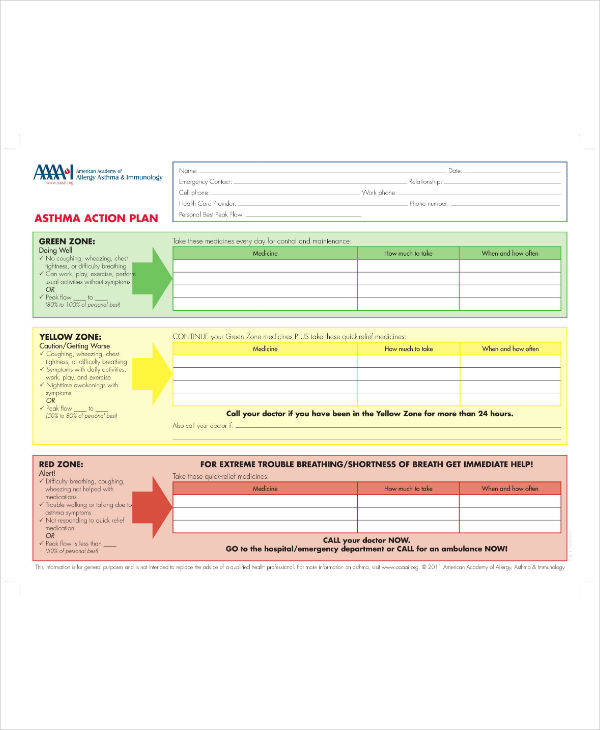 aaaai.org
aaaai.org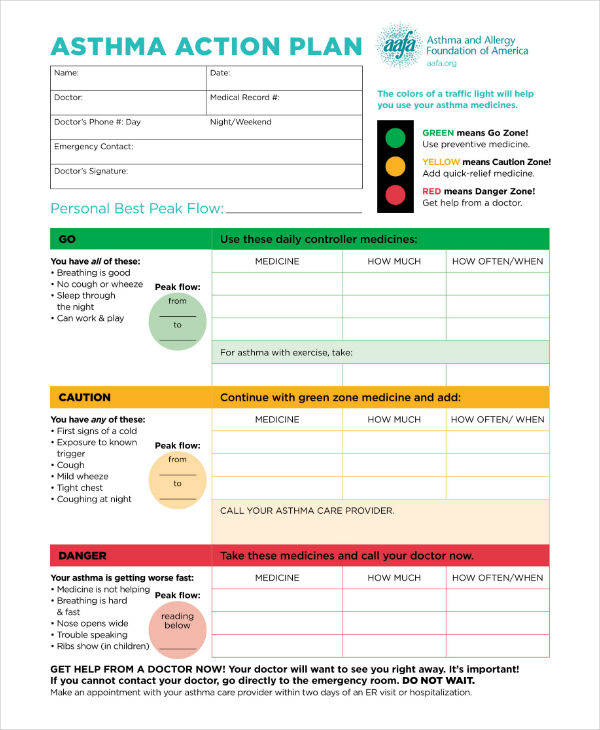 aafa.org
aafa.orgManaging asthma is crucial for people who are suffering from the disease to maintain a great quality of life. Managing the medications that are essential in keeping asthma at bay is one thing that asthmatics need to be mindful of. They should bear in mind as to which kind of medication is appropriate for their situation, whether they be long-term or short-term medications. You may also see school action plans.
Inadequate access and management of these medications are what mostly cause poor asthma control most of the time. Another way of managing asthma is to avoid the triggers and stimuli that irritate and inflame their person’s airways. An asthma patient must ask his medical support’s help in order to learn which triggers that he or she should avoid. You may also see sample action plans.
One tool that can help in the management of asthma is the asthma action plan. Action plan samples, in general, are documents that list which steps must be taken in order to achieve a goal. In the case of the asthma action plan, this goal is to recognize worsening asthma conditions and detail the steps on what to do in response. Asthma action plans are usually developed and written by the person who has the condition, their carers, and their doctors. The development of an asthma action plan should be discussed properly by these people to be able to prepare one that is appropriate and fits well with the person who is going to use it.
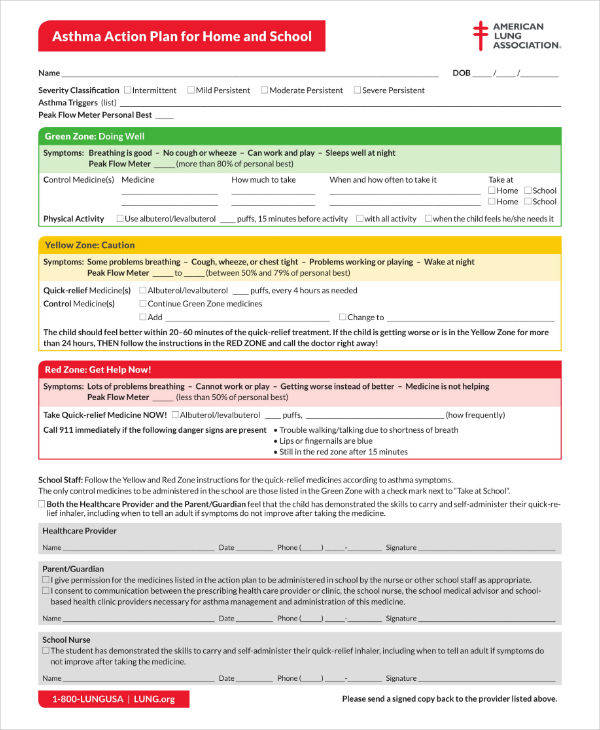 lung.org
lung.org childhealthbc.ca
childhealthbc.ca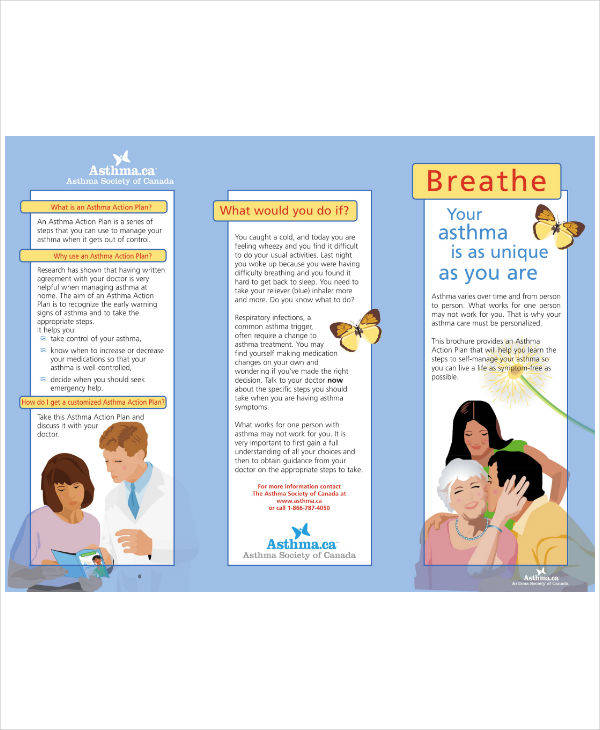 asthma.ca
asthma.caDifferent asthma action plans suit different kinds of people. One patient’s treatment and management methods may not work with another, as such, cutting corners should never be done when creating documents such as asthma action plans. However, to make them be easily understood and to just keep in format. An asthma action plan should have the characteristics below. You may also see allergy action plans.
An asthma action plan should include some basic details, to begin with. The patient’s name, their doctor’s contact details should be specified as well as the patient’s emergency contact. The date when the sample action plan was originally issued should also be included. Other main elements that the asthma action plan should have are:
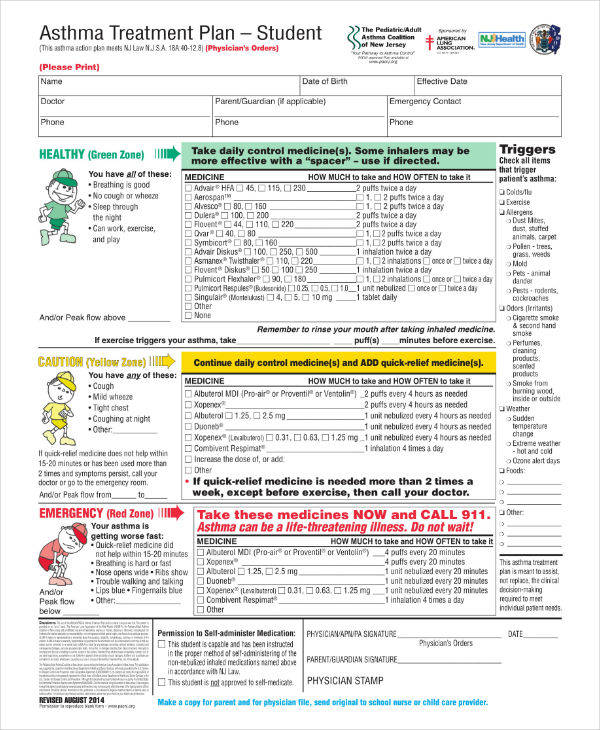 pacnj.org
pacnj.org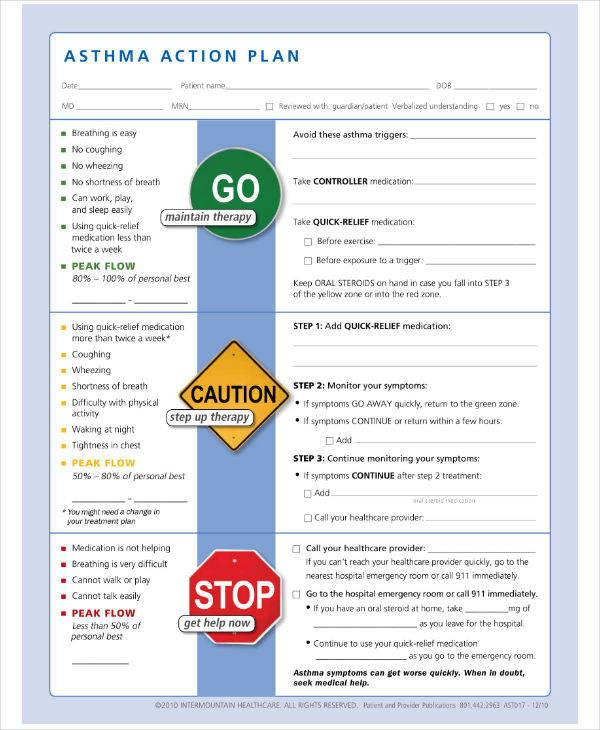 health.utah.gov
health.utah.gov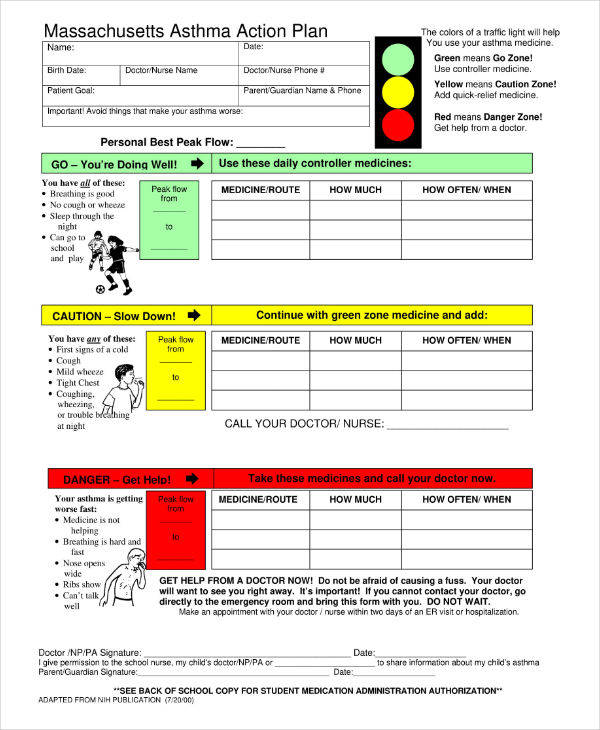 mhqp.org
mhqp.orgAll asthma action plans are divided into three zones. These so-called asthma zones indicate the level of asthma the patient is currently in. This zone system brings to mind the colors commonly seen in traffic lights: green, yellow, and red. The colors indicate how asthma should be treated from day to day. You may also see action plan word.
The green asthma zone is the ideal zone for asthmatics. These indicate how asthma should be treated when the patient is feeling well. Symptoms are non-existent in this zone thus the patient often feels good. Despite that, the said patient should still continue taking their long-term medicine in this zone. You may also see business action plan templates.
The yellow asthma zone is the zone where asthmatics should watch out. The patients in this zone are usually experiencing symptoms of asthma. These symptoms may be mild to moderate and will cause mild discomfort such as not being able to do usual activities or disturbance and not being able to sleep. When writing the action plan, these zones should indicate the which of the symptoms should be watched out and which medicines should be taken to bring it back to the green zone. You may also see sample emergency action plans.
All in all, the yellow zone should indicate to the patient that their asthma is not in their control and care should be taken immediately. If the patient continues going back in forth between yellow and green then it is time for them to go see a doctor. You may also see a sample strategic plan templates.
Red means emergency. The red asthma zone is where the patient should never want to be. When they are in this zone, the patient is suffering from severe asthma symptoms or an asthma flare-up. This zone usually indicates what to do when the patient is suffering from such symptoms. Immediately call the doctor or go to the hospital when the patient is in this zone. To put it simply, the red zone is usually the danger zone. You may also see career action plans.
The zone in which the patient’s asthma is often indicated by either their symptoms or peak flow rates.
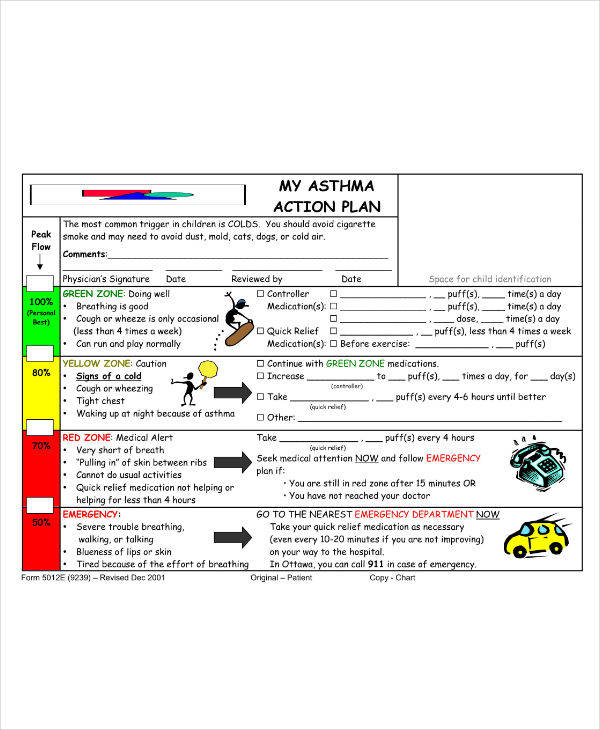 cheo.on.ca
cheo.on.ca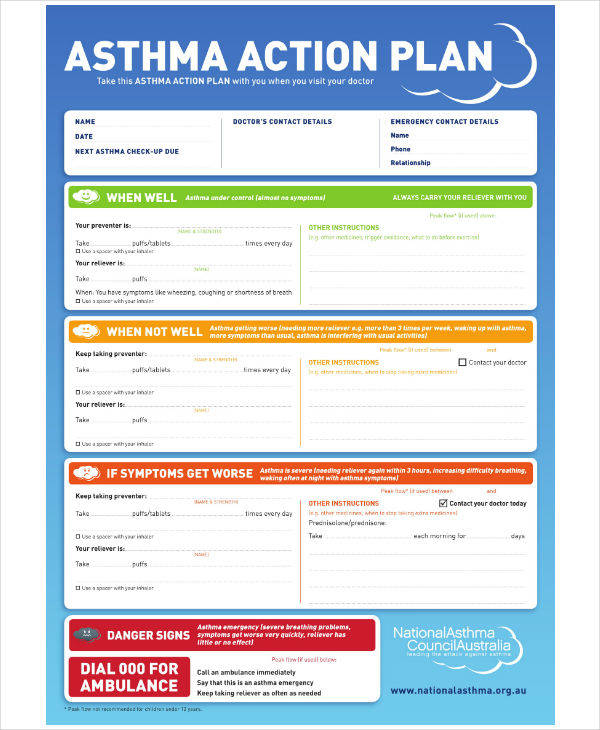 assets.nationalasthma.org.au
assets.nationalasthma.org.auAs mentioned above, peak flow rates are one of the factors used to indicate in which zone the patient’s asthma is currently in. Peak flow rates are often used by healthcare providers to monitor the patient especially if they have moderate to severe asthma. The advantage of using a peak flow rate is that it allows one to see the patient’s asthma even before the symptoms are felt. The peak flow rate is usually measured with a peak flow meter. You may also see sample affirmative action plans.
To make great use of the peak flow rate, the first step is to measure the patient’s personal best. This personal best, which is the highest peak flow number the patient achieves in a two to three week period, is then compared the current peak flow rate to determining which asthma zone the patient is in. If the peak flow rate from one hundred to eighty percent then he is in the green zone. If it is between eighty to fifty percent, then he is in yellow. Anything below that means that the patient is in the danger or red zone. You may also see simple action plan formats.
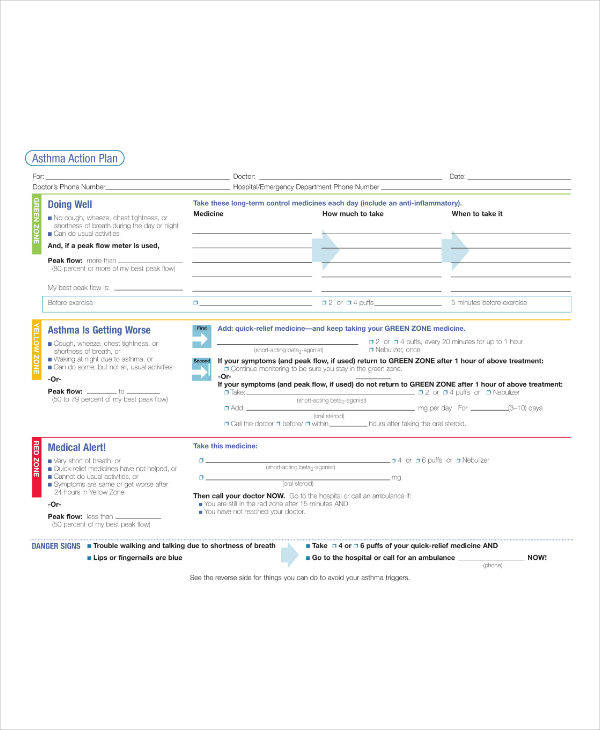 nhlbi.nih.gov
nhlbi.nih.gov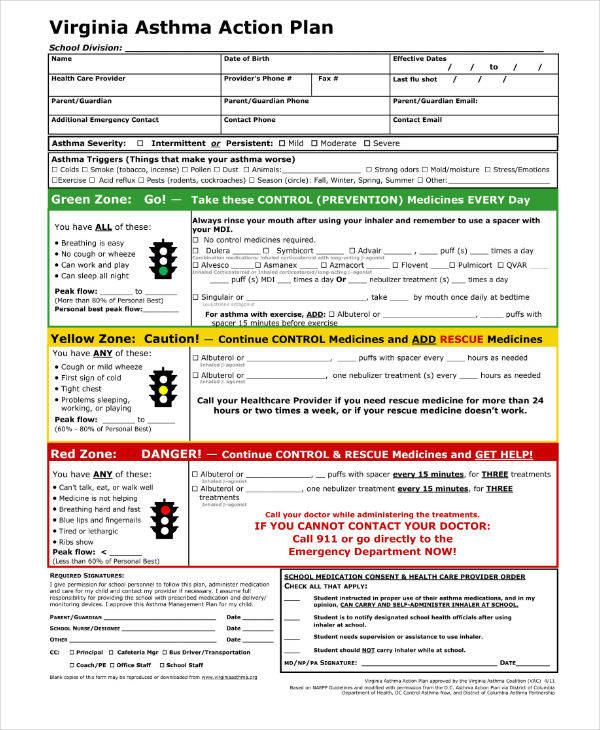 vsdb.k12.va.us
vsdb.k12.va.usA patient should only develop their asthma action plan in conjunction with their care provider. Asthma is a serious disease that needs a professional’s expertise in order to be properly treated. That being said, the doctor should also consider the patient’s preferences when creating the plan. The patient should provide these preferences to the doctor to refine the plan that is essential to their treatment but also comfortable enough. You may also see project action plans.
The action plan is made for the patient, and naturally, they should follow it for their own good. By following the action plan, handling asthma episodes will be easier and more manageable. This is because the action plan can be used to recognize the symptoms earlier and as such, they can be treated as soon as possible. You may also see employee action plans.
In conjunction with the asthma action plan, the patient is encouraged to develop an asthma diary. This diary can be used to keep track of any developments that relate to asthma. This diary will be very useful for the patient’s next checkup with the doctor. Aside from the symptoms, the patient can also write any questions the patient has relating to his current situation. You may also see emergency action plans.
Both the asthma action plan and the supplemental asthma diary are used to help the patient manage the patient’s asthma. The patient’s condition may change over time, and as such, the doctor and the patient should update them accordingly. As the patient, always make sure to inquire about your symptoms whenever visiting the doctors. Always examine with your doctor as to which parts of the plan work and which do not and then change them accordingly. You may also see make an action plan.
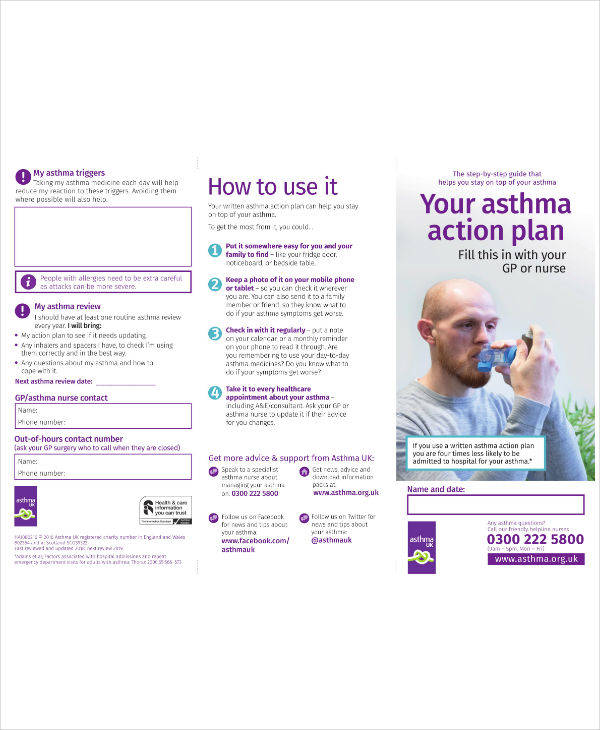 asthma.org.uk
asthma.org.ukAsthma is not only a pain in the neck to deal with. It is overall painful and deadly. Seeing that asthma has no cure, asthma management is crucial for those people suffering from it to increase their quality of life. One helpful tool in monitoring a patient’s asthma is the asthma action plan. You may also see incident action plans.
The asthma action plan is a document that details the symptoms a patient should watch out for on his asthma and how to treat them accordingly. This action plan on asthma is usually divided into three zones which are named after the colors of a traffic light. The zone where the patient’s asthma is in depends on the symptom detailed on the plan. Lastly, asthma action plans should be developed in conjunction with the doctor in order for the patient to know the proper medication in tackling their condition. You may also see sample incident action plans.

Empowering the youth to become the best can be such a fulfilling task to accomplish. But, school counselors proved that…

A compensation plan is the detailed plan of an employee’s wages, salaries, benefits and the terms of payment. The plan…

As there is a saying that ” with big positions comes the big responsibilities”. It is the huge duty to…

The student recruitment plan is one of the most important and essential parts of educational institutions. The strategy interacts with…

The recruitment and retention are two different terms explaining the thing that is inter-related. Recruitment is the process of identifying,…

A College Recruitment Plan is the designed plan or a strategy that is developed to recruit the employees of a…

A Recruitment Action Plan is a strategy that is designed for putting the recruiting process into action. This is the…

A recruitment business plan is one of the necessities for a company. It does not just help you to map…

Clinical trial recruitments are considered to be very essential to the success of any clinical study and it is often…